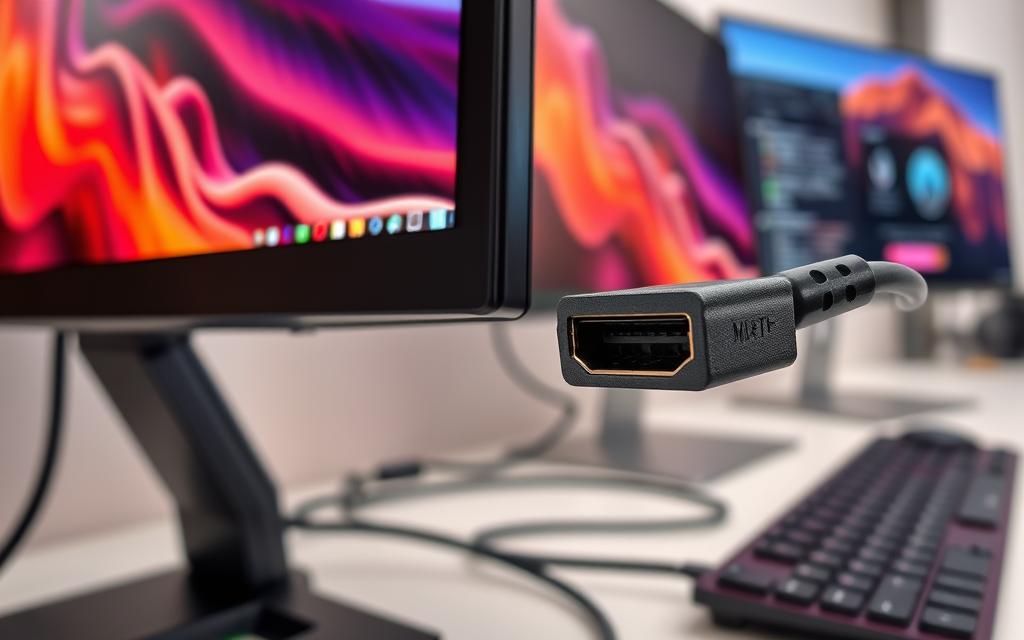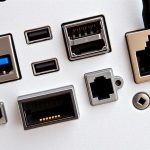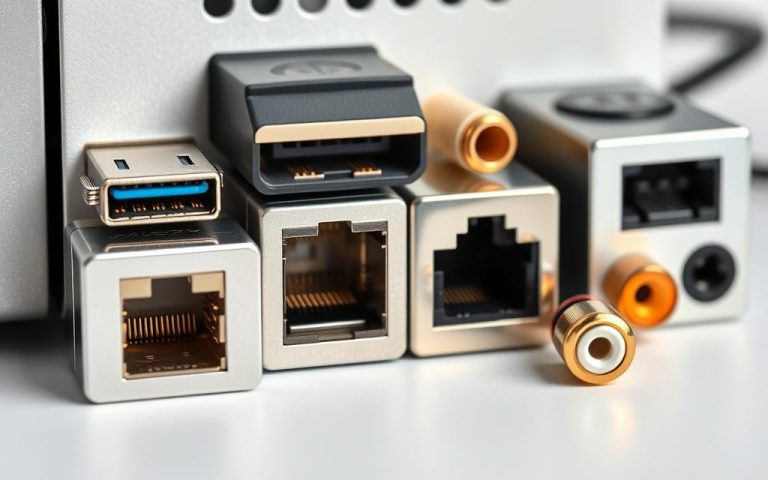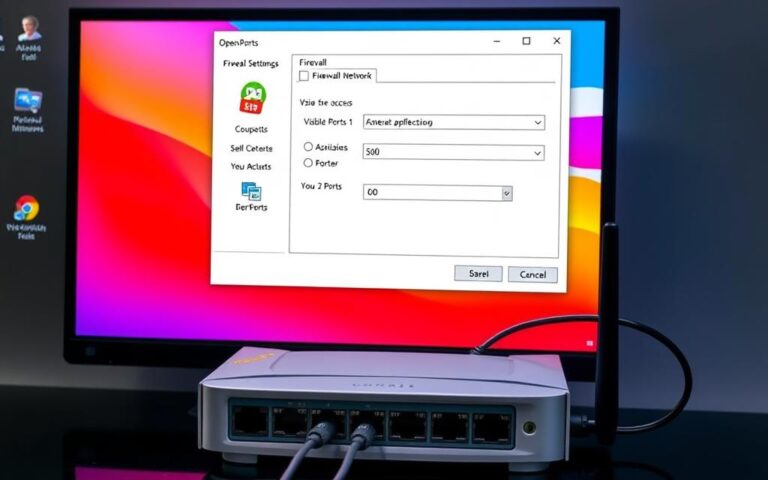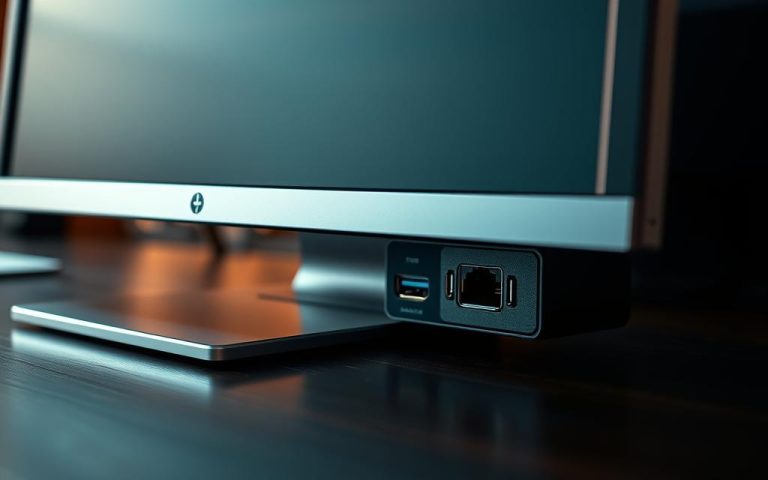What Is a DP Port on a Computer and How Is It Used?
The DP port, also known as DisplayPort, connects video sources to displays. It’s a modern interface for digital video transmission. This includes connections from graphics cards to monitors and TVs.
Its main role is to ensure top-notch audio and video quality. This is crucial for gaming and multimedia editing. Thanks to its design, the DisplayPort can handle high resolutions and fast refresh rates. This leads to clear images and smooth motion on screen.
Understanding DisplayPort Technology
DisplayPort technology is a big leap forward in digital interface design. It connects display devices to various data sources. This interface, made by VESA, is now more popular than old standards like VGA and DVI. It sends high-definition sound and images.
Definition of DisplayPort
DisplayPort is a strong way to connect modern screens, moving lots of data for sharp images. It works with many connectors, including Mini DisplayPort, which is small but powerful. This makes DisplayPort common in computers, laptops, and TVs.
Types of DisplayPort
There are several versions of DisplayPort, each improving performance for new tech demands. Here’s a look at the main types:
| DisplayPort Version | Data Transfer Rate | Maximum Resolution | Additional Features |
|---|---|---|---|
| DisplayPort 1.2 | 17.28 Gbps | 4K at 60Hz | Supports multiple video streams |
| DisplayPort 1.4 | 32.4 Gbps | 8K at 60Hz with DSC | 32 audio channels, HDR10 metadata |
| DisplayPort 2.0 | 77.37 Gbps | Beyond 8K | Higher refresh rates, enhanced dynamic range |
| DisplayPort 2.1 | 40 Gbps and 80 Gbps | Advanced display setups | Compatible with USB4 and USB-C |
DisplayPort technology has made big strides, letting us use digital displays better. It gives excellent sound and video quality. It works with many devices.
What Is a DP Port on a Computer
A DP port is where you plug in DisplayPort cables on a computer. It sends high-quality video and sound to screens, like monitors and TVs. This makes your computer ready for things like gaming and watching movies in stunning detail and clarity.
As tech has grown, the DP port is now often chosen over older types. It’s perfect for people who need their visuals smooth and who use more than one screen. With DP ports, connecting several monitors with just one cable each is simple. This setup is great for doing lots of tasks at once or big projects.
Moving to DP ports means a big improvement from the old VGA or DVI. DisplayPort lets you see sharper images and enjoy faster refresh rates. It’s becoming a favourite for new tech because it’s so flexible. That means you can watch or create top-notch content on different devices without losing quality.
| Feature | DisplayPort | HDMI |
|---|---|---|
| Max Resolution | 8K and beyond | 8K |
| Supported Refresh Rates | Up to 240Hz (higher with DisplayPort 2.1) | Limited compared to DisplayPort standards |
| Multi-Monitor Support | Yes, via MST | No |
| Audio Transmission | Yes | Yes |
| Typical Use Cases | Gaming and professional applications | Home entertainment systems |
Key Features of DisplayPort
DisplayPort is known for its powerful features. These features really stand out for high resolutions and refresh rates. Both professionals and gamers will find these specs useful for better visuals on many screens.
High Resolution and Refresh Rates
DisplayPort is ahead because it supports very high resolutions. With DisplayPort 1.4, you get 8K resolution at 60Hz. The newer DisplayPort 2.0 even offers up to 16K with HDR at 60Hz. These high resolutions and fast refresh rates mean visuals are smooth and clear.
The bandwidth with DisplayPort 1.4 reaches up to 32.4 Gbps. This high bandwidth makes sure data-heavy tasks run smoothly without any lag.
Multiple Monitor Support
DisplayPort’s ability to connect multiple monitors with one cable is pretty impressive. This makes setting up a multi-screen workstation much easier and helps increase productivity. It supports high resolutions on all monitors. This is great for gaming or work, needing clear visuals and a lot of screen space.
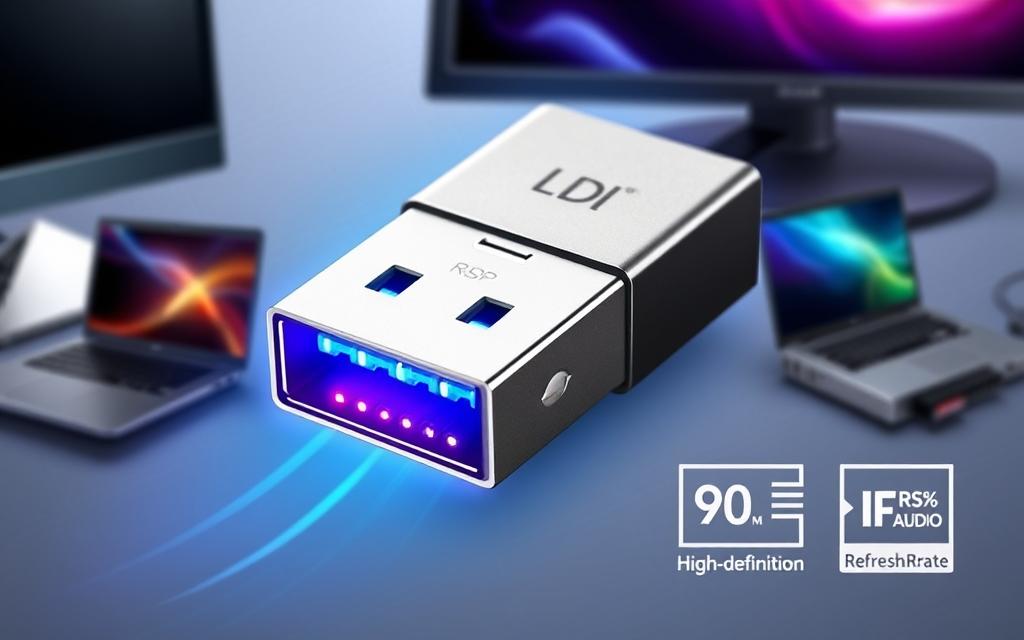
Comparing DisplayPort with Other Interfaces
Understanding how DisplayPort differs from other interfaces shows each technology’s strengths. HDMI is king in TV and home entertainment. But, DisplayPort shines in computing, where top-notch performance matters. This DisplayPort comparison highlights important features for users.
DisplayPort vs HDMI
Looking at HDMI and DisplayPort, their differences in resolution, refresh rates, and adaptability stand out. Here’s a table with key info:
| Feature | DisplayPort | HDMI |
|---|---|---|
| Introduced | 2006 | 2003 |
| Max Resolution | 8K at 60Hz (1.4) | 4K at 60Hz (2.0) |
| Max Bandwidth | 80 Gbps (UHBR) | 18 Gbps (2.0) |
| Cable Length | Up to 15m | Typically 5m |
| Daisy Chaining | Yes | No |
Advantages of DisplayPort Over HDMI
DisplayPort has several advantages for those needing top performance. These benefits are important:
- It supports higher resolutions and faster refresh rates, great for gaming and work.
- It enhances visual quality with HDR and adaptive sync technologies.
- Longer cables mean you can set up your equipment further apart without losing quality.
- With daisy chaining, connecting several monitors is simple.
Conclusion
DisplayPort is key for modern computer connections. It offers top-notch audio and video quality. It is crucial for gamers, creators, and pros because of its high resolutions, refresh rates, and ability to connect multiple monitors. Understanding the benefits of DP helps people choose the best tech setups.
DisplayPort is versatile with standards like DP and DP++ ports. These ports support a wide range of devices, from laptops to high-end monitors and projectors. They ensure easy connections across various devices.
DisplayPort is a powerful and flexible interface. It meets the growing needs of the tech world. Its performance and role in boosting productivity and user experience are key. DisplayPort is essential for anyone wanting strong and top-quality connections.
FAQ
What is a DP port on a computer?
A DP port, or DisplayPort, is a digital interface on computers. It transmits high-quality audio and video. It connects video sources like graphics cards to displays such as monitors and projectors.
What are the main features of DisplayPort?
DisplayPort has top specs, like supporting up to 16K resolution. It has high refresh rates. You can also link multiple displays from one connection. This makes it perfect for gaming and professional use.
How does DisplayPort compare to HDMI?
HDMI is often used in TVs and for home entertainment. DisplayPort, though, is made for computing. It supports higher resolutions and refresh rates. It also handles multiple monitors better.
What types of DisplayPort connections are available?
There are two main DisplayPort connections: standard and Mini DisplayPort. They work the same but differ in size. The Mini DisplayPort is smaller, great for portable devices.
Can I use a DP cable with an HDMI device?
Yes, with a DisplayPort to HDMI adapter or cable, you can connect. But, make sure the adapter can handle your needed resolution and refresh rate.
What advantages does DisplayPort have over older interfaces like VGA and DVI?
DisplayPort beats old tech like VGA and DVI. It offers more bandwidth, supports 4K and 8K, and transmits audio and video together.
Is DisplayPort backward compatible with older interfaces?
DisplayPort is backward compatible. With the right adapters or cables, you can link to different display devices smoothly.

